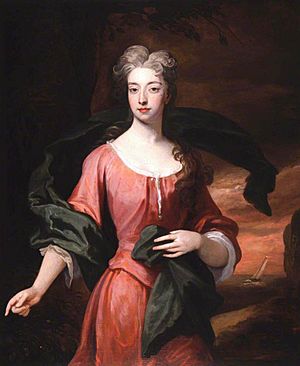Elizabeth Southwell facts for kids
Quick facts for kids
Elizabeth Southwell
|
|
|---|---|

Elizabeth Southwell in 1705
|
|
| Born | 3 December 1674 |
| Died | 31 March 1709 (aged 34) |
| Buried | Henbury |
| Noble family | Cromwell |
| Spouse(s) | Edward Southwell |
| Issue | Edward Southwell |
| Father | Vere Essex Cromwell, 4th Earl of Ardglass |
| Mother | Catherine Hamilton |
Lady Elizabeth Southwell (born Cromwell), also known as Lady Cromwell (1674–1709), was an English noblewoman. She was the only daughter of Vere Essex Cromwell, 4th Earl of Ardglass and his wife, Catherine Hamilton.
What Was Her Title?
When Lady Elizabeth's father died in 1687, she claimed his title of Baron Cromwell. His higher titles, like Earl and Viscount, ended because he had no sons. Lady Elizabeth was even ranked with other noblewomen at important events. These included the funeral of Queen Mary II and the crowning of Queen Anne. However, it seems her claim to the barony might have been a mistake.
Whether she could inherit the title depended on how it was first created. A "barony by writ" could pass to an only daughter if there were no sons. But a "barony by patent" usually went only to male heirs. This would mean daughters could not inherit.
The Barony of Cromwell was created by a "patent" in 1540. It was given to Gregory Cromwell, 1st Baron Cromwell, and his male heirs. Gregory was the son of Thomas Cromwell, 1st Earl of Essex, a powerful minister to King Henry VIII. An old historian named William Dugdale claimed in the 1670s that there was also a "writ" for Gregory Cromwell. A writ is a formal order to attend Parliament. However, the form of this writ was unusual. Also, no writs were recorded on that specific day. Experts now believe Dugdale might have been mistaken. He may have seen a reference to "Lord Cromwell" and thought it meant Gregory, not his father.
Love, Marriage, and Family
In 1703, a wealthy American planter named William Byrd II tried to win Lady Elizabeth's affection. She was traveling to Dublin with Edward Southwell. He was the Secretary of State for Ireland. Byrd and Southwell were good friends at the time. Byrd wrote many letters to Lady Elizabeth, calling her 'Facetia' and himself 'Veramour'.
Lady Elizabeth's replies to Byrd's letters are lost. But Byrd's letters show he became annoyed when she stopped writing back. He grew angry and criticized her "laziness." This probably ruined any chance he had of marrying her.
On October 29, 1704, Lady Elizabeth married Edward Southwell in Ireland. They had a son, also named Edward Southwell. Their son did not use the title Baron Cromwell. Lady Elizabeth's grandson later inherited a much older and more famous title, the Barony of Clifford. He became the 20th person to hold that title.
Her Final Years
Elizabeth died from consumption (a serious lung disease) on March 31, 1709. She was buried in Henbury. A friend, Lady Wentworth, wrote about her death the next day. She said Lady Elizabeth was a "very good wife" and left behind "three lovely boys and a dismal melancholy husband."

